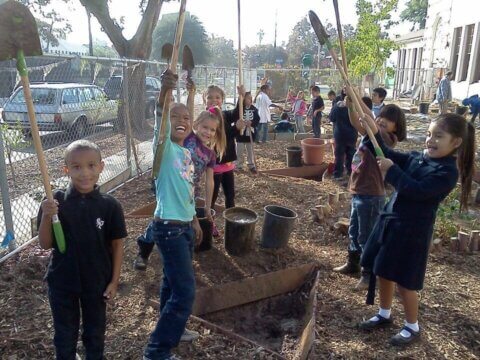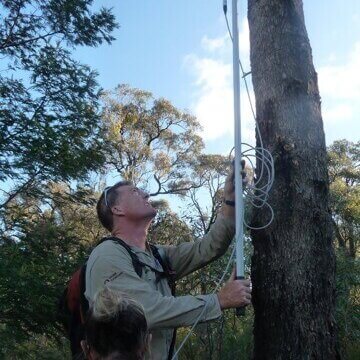CONNECTING WITH VITAMIN N: A Ten-Year Reflection from One of Canada’s Leading Conservationists
When I read that Richard Louv had published Vitamin N: The Essential Guide to a Nature-Rich Life, it caused me to pause and reflect on my history with the child and nature movement.

Photo by Shutterstock; Robin Rivet; Larry Volpe
Like so many people my age, I was raised “in nature” – running through corn fields, fishing in the nearby pond and hunting squirrels in the local park. This led to many summers canoeing the rivers and lakes of Northern Ontario and eventually being hired, fresh out of university, as a naturalist by the federal government. I believe strongly that I am who I am – a biologist, birdwatcher, hiker, kayaker, amateur gardener and, most importantly, an advocate for protecting nature – because of those formative years playing outside.
It was 10 years ago when I first stumbled upon Richard Louv’s best-selling book “Last Child in the Woods: Saving Our Children from Nature-Deficit Disorder.” Nature-deficit disorder? How could this be? Surely children were still rambling around outside. However, as Louv pointed out in Last Child, the evidence was to the contrary. I was determined to learn more about this unhealthy and disturbing trend.
I wanted to do more than just learn about nature-deficit disorder. I wanted to do something to reverse the trend.
I thought to myself, ‘why isn’t the best place to start to track down the author himself?’ Which is exactly what I did. I phoned Richard and essentially said, “Hi, I’m Bob. Thank you for writing this important book and putting this key issue of nature-deficit disorder on the public radar. If I can get a bunch of people together will you come to Victoria, British Columbia, to attend a workshop and give a public lecture?” Richard agreed. And the workshop he attended was the catalyst for what would become the child and nature movement in Canada.
For me, it’s important to tell this story for a number of reasons.
It reinforces Margaret Mead’s belief that one should never doubt that an individual or a small group of thoughtful, committed citizens can make a difference.
I am confident that Richard Louv’s books have influenced people all around the world and how they choose to live their lives and interact with nature. Personally, my determination led to the formation of the Child and Nature Alliance of Canada, which has served as a critical element in understanding the importance of playing outdoors and being outside.
Ten years later, I know of no other factor (except addressing climate change) that is of such profound importance to the future of wildlife, the oceans and the natural systems that we depend on.
That advocacy and that voice often comes from the understanding one develops by being outside, experiencing the sights, sounds and smells of the web of life.
Also, it’s valuable to share about the positive success stories of the child-nature movement. It can often feel discouraging to be part of today’s world, as it seems there is little progress in addressing climate change, stopping the logging of valuable forests, reducing the suffering that comes from poor health or finding homes for those less fortunate.
Ten years ago, the importance of being outside and the value of playing in nature for children and their families wasn’t even on the public radar. Today, one can hardly go to a garden party, read a newspaper or listen to the news without reference to the fact that being outside and having direct exposure to nature is essential to a child’s healthy, physical and emotional development and a person’s well-being.
Our movement has had great success and we should all be proud of the momentum we are building to address nature-deficit disorder both at the community and the government policy level. And, for me, that provides hope.
We must not allow children and families ‘getting outside’ to be an endangered element of today’s society. The health of the community where we live, the health of the children among us and the health of the planet we live on are all dependent on this connection with Vitamin N.
I recall a wise person once saying to me: “Remember Bob, it isn’t just what kind of world we are leaving for our children, but also what kind of children are we leaving for the world.”
Commentaries here and elsewhere on the C&NN website are offered to inform readers and to stimulate new thinking and debate. C&NN does not officially endorse every statement in every commentary.
-
Network News
POLICY UPDATE: Policy and advocacy for the children and nature movement
-
Voices
Binoculars, bald eagles and my journey as a Black birder
-
Richard Louv
THE WONDER BOWL: Ten Spring and Summer Nature Activities for Kids and Adults
-
Network News
Minneapolis Spotlight: The promise and possibilities of parks for youth
-
Voices
Why nature is my motherhood ally





Commentaries on the C&NN website are offered to share diverse points-of-view from the global children and nature movement and to encourage new thinking and debate. The views and opinions expressed are those of the author(s) and do not necessarily reflect the position of C&NN. C&NN does not officially endorse every statement, report or product mentioned.